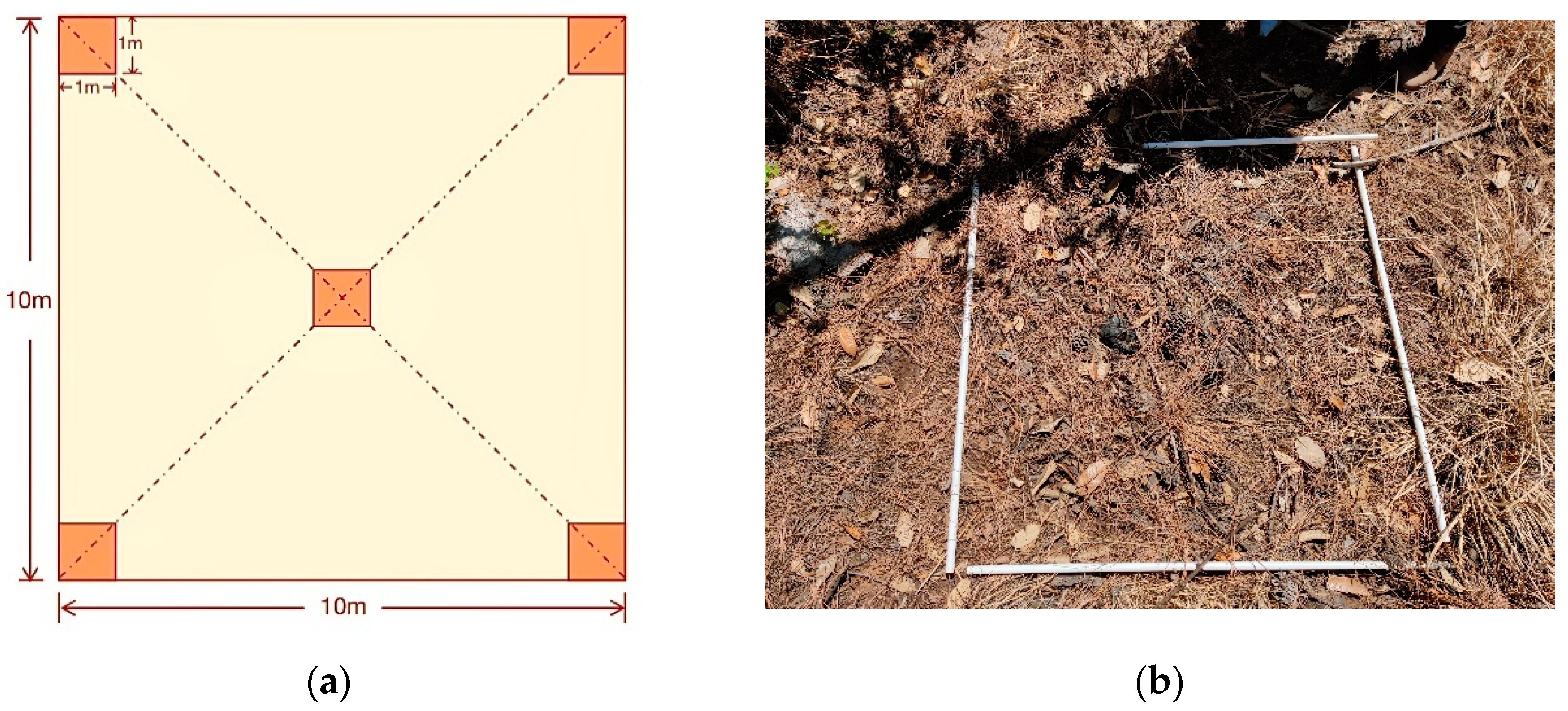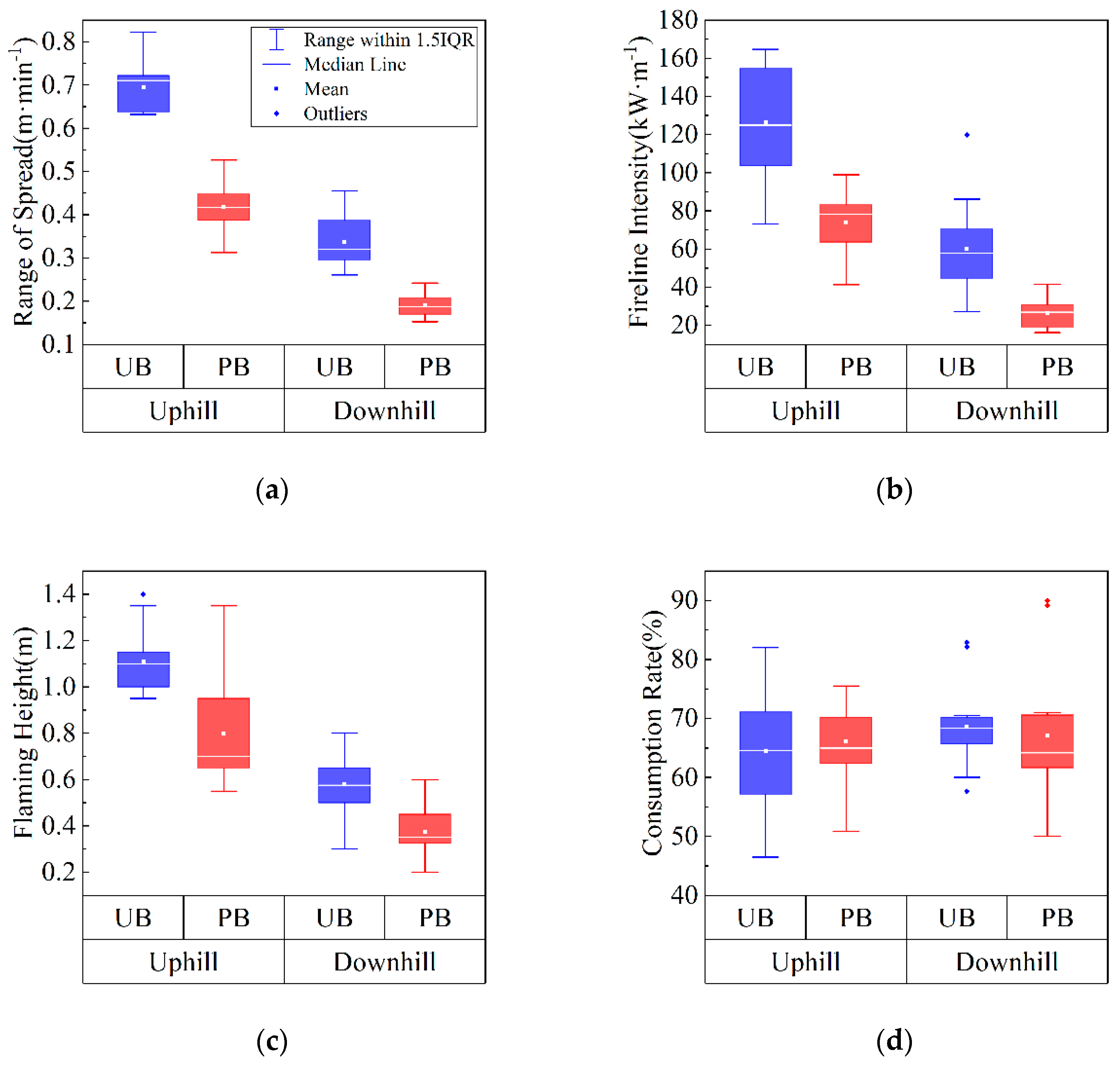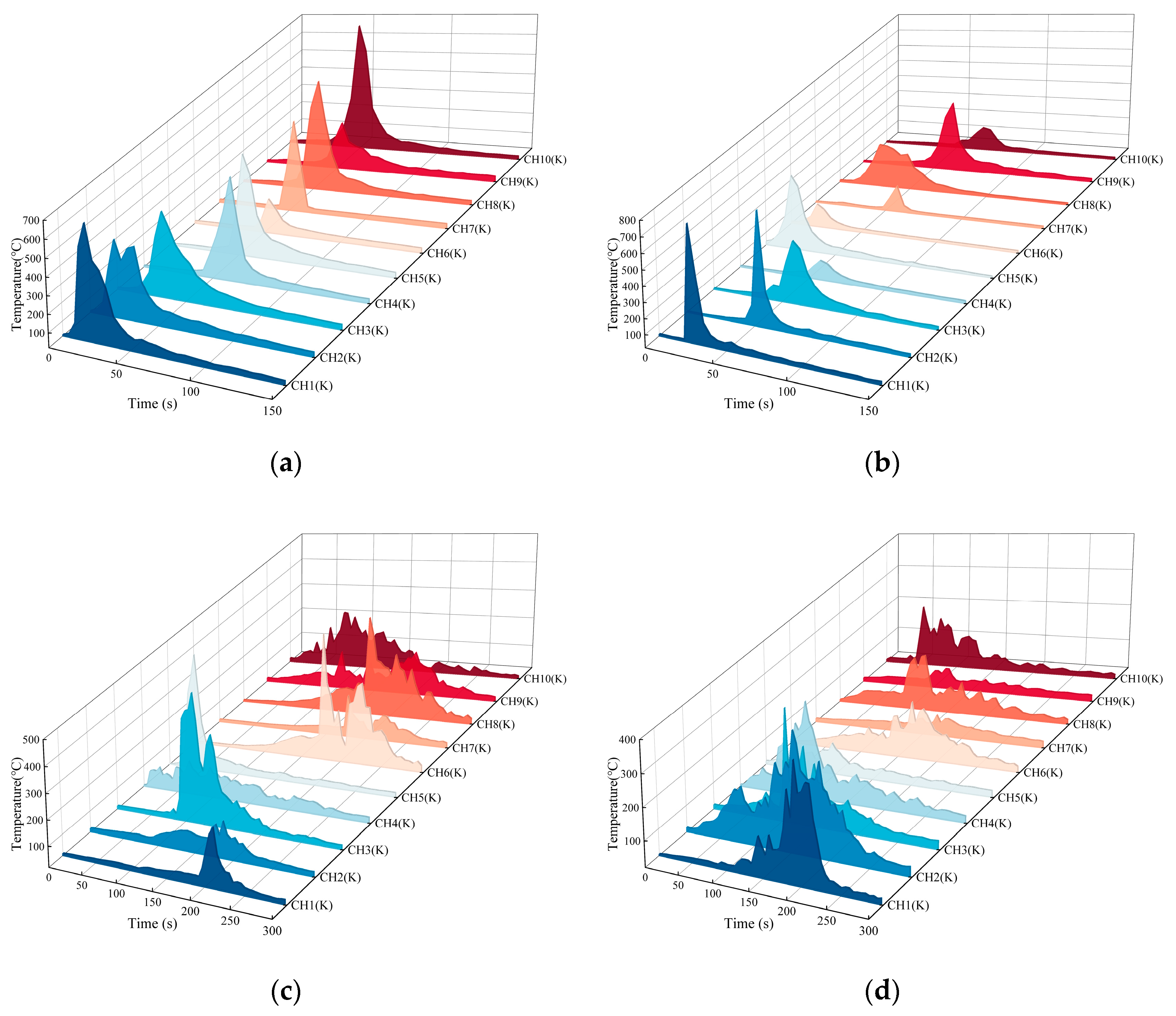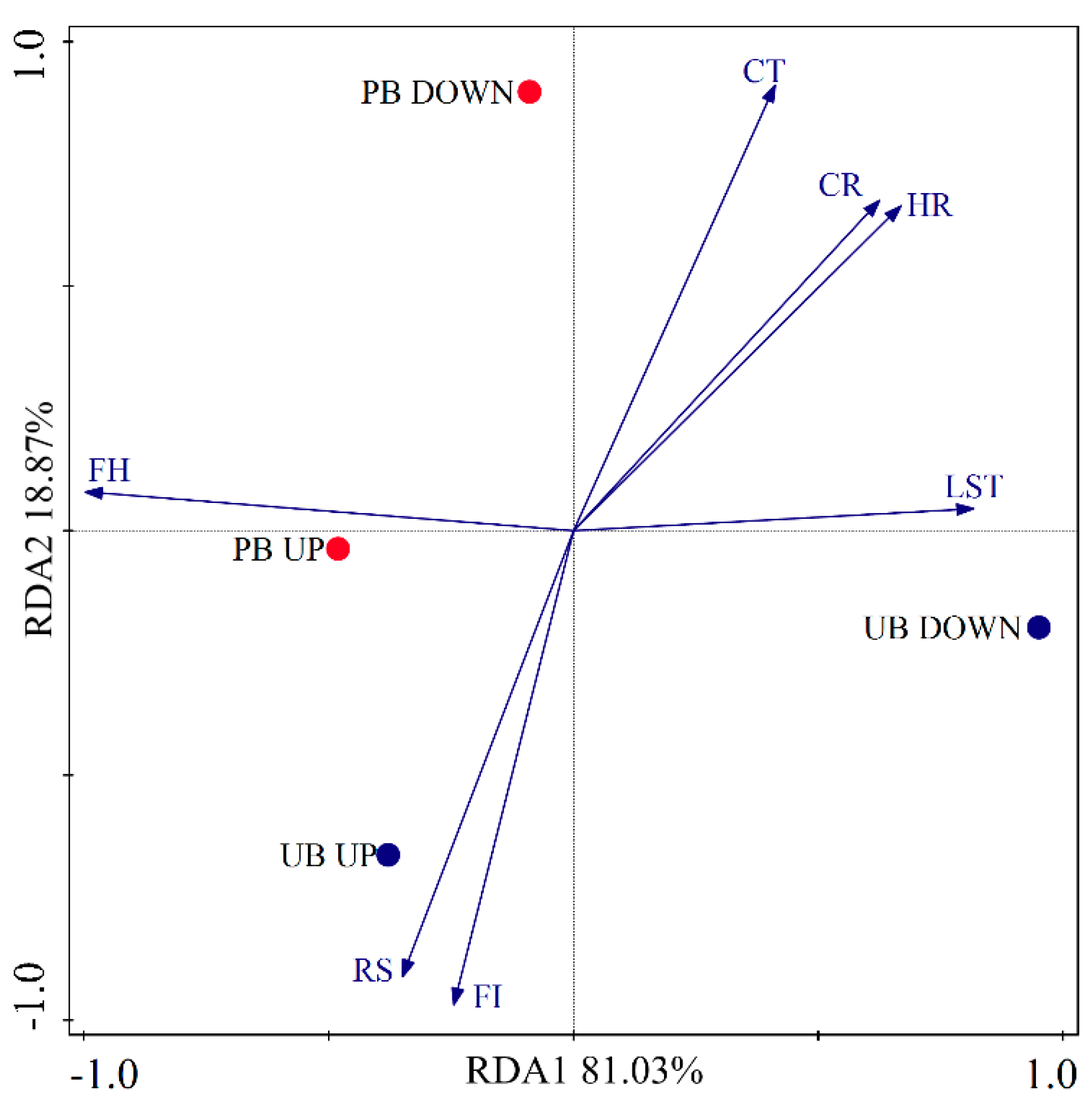How Prescribed Burning Affects Surface Fine Fuel and Potential Fire Behavior in Pinus yunnanensis in China
Abstract
:1. Introduction
2. Methods and Materials
2.1. Study Site and Experimental Design
2.2. Description of the Surface Fine Fuel Structure in a Sample Plot
2.3. Sample Analysis
2.3.1. Determination of FMC
2.3.2. Determination of Ash Content
2.3.3. Determination of Crude Fat Content
2.3.4. Determination of HHV
2.4. Potential Fire Behavior Testing
2.5. Redundancy Analysis
2.6. Statistical Analysis
3. Results
3.1. Forest Stand Characteristics of P. yunnanensis Forest
3.2. Physicochemical Characteristics of Fine Fuel
3.3. Potential Fire Behavior of Fine Fuel
3.4. Association Between the Potential Fire Behavior of Fine Fuel and Effects of Prescribed Burning
3.5. Association Between the Potential Fire Behavior of Fine Fuel and Effects of Slope
4. Discussion
4.1. Characteristics of the P. yunnanensis Forest Stand
4.2. Effect of Prescribed Burning on the Structure of Surface Fine Fuel
4.3. Differences in Physicochemical Characteristics of Fine Fuels
4.4. Differences in Potential Fire Behavior of Fine Fuel Under Effects of Prescribed Burning
4.5. Differences in the Potential Fire Behavior of Fine Fuel Under Effects of Slope Degrees
5. Conclusions
Author Contributions
Funding
Data Availability Statement
Conflicts of Interest
References
- Zhao, J.; Yue, C.; Wang, J.; Hantson, S.; Wang, X.; He, B.; Li, G.; Wang, L.; Zhao, H.; Luyssaert, S. Forest Fire Size Amplifies Postfire Land Surface Warming. Nature 2024, 633, 828–834. [Google Scholar] [CrossRef] [PubMed]
- Jain, P.; Castellanos-Acuña, D.; Coogan, S.; Abatzoglou, J.; Flannigan, M. Observed Increases in Extreme Fire Weather Driven by Atmospheric Humidity and Temperature. Nat. Clim. Change 2022, 12, 63–70. [Google Scholar] [CrossRef]
- Han, Y.; Wang, Y.; Gao, G. Fine Fuels, Equilibrium Moisture Content, and Time-lag of Several Forest Types. J. Northeast. For. Univ. 2018, 46, 62–65. [Google Scholar] [CrossRef]
- Burrows, N.D.; McCaw, W.L. Fuel Characteristics and Bushfire Control in Banksia Low Woodlands in Western Australia. J. Environ. Manag. 1990, 31, 229–236. [Google Scholar] [CrossRef]
- Department for Environment and Water. Managing Fuel Hazards. Available online: https://www.environment.sa.gov.au/topics/fire-management/managing-bushfire-risk/managing-fuel-hazards (accessed on 23 October 2024).
- Volkova, L.; Weston, C.J. Effect of Thinning and Burning Fuel Reduction Treatments on Forest Carbon and Bushfire Fuel Hazard in Eucalyptus Sieberi Forests of South-Eastern Australia. Sci. Total Environ. 2019, 694, 133708. [Google Scholar] [CrossRef]
- Ottmar, R.D.; Blake, J.I.; Crolly, W.T. Using Fine-Scale Fuel Measurements to Assess Wildland Fuels, Potential Fire Behavior and Hazard Mitigation Treatments in the Southeastern USA. For. Ecol. Manag. 2012, 273, 1–3. [Google Scholar] [CrossRef]
- Boer, M.M.; Sadler, R.J.; Wittkuhn, R.S.; McCaw, L.; Grierson, P.F. Long-Term Impacts of Prescribed Burning on Regional Extent and Incidence of Wildfires-Evidence from 50 Years of Active Fire Management in SW Australian Forests. For. Ecol. Manag. 2009, 259, 132–142. [Google Scholar] [CrossRef]
- Johnston, M.T.; Miller, A.D.; Holland, O.J.; Clark, Z.; Wevill, T. Impacts of Planned Burning on the Fungal Diversity and Vascular Plants in a Heathy Woodland. For. Ecol. Manag. 2024, 563, 121958. [Google Scholar] [CrossRef]
- Penman, T.D.; Christie, F.J.; Andersen, A.N.; Bradstock, R.A.; Cary, G.J.; Henderson, M.K.; Price, O.; Tran, C.; Wardle, G.M.; Williams, R.J.; et al. Prescribed Burning: How Can It Work to Conserve the Things We Value? Int. J. Wildland Fire 2011, 20, 721–733. [Google Scholar] [CrossRef]
- Cogos, S.; Östlund, L.; Roturier, S. Fire Management in the Boreal Forest of Swedish Sápmi: Prescribed Burning and Consideration of Sami Reindeer Herding during 1920–1970. Environ. Manag. 2021, 68, 295–309. [Google Scholar] [CrossRef]
- Furlaud, J.M.; Williamson, G.J.; Bowman, D.M.J.S. Simulating the Effectiveness of Prescribed Burning at Altering Wildfire Behaviour in Tasmania, Australia. Int. J. Wildland Fire 2017, 27, 15–28. [Google Scholar] [CrossRef]
- Godfree, R.C.; Knerr, N.; Encinas-Viso, F.; Albrecht, D.; Bush, D.; Christine Cargill, D.; Clements, M.; Gueidan, C.; Guja, L.K.; Harwood, T.; et al. Implications of the 2019–2020 Megafires for the Biogeography and Conservation of Australian Vegetation. Nat. Commun. 2021, 12, 1023. [Google Scholar] [CrossRef] [PubMed]
- Vermeire, L.; Mitchell, R.; Fuhlendorf, S.; Wester, D. Selective Control of Rangeland Grasshoppers with Prescribed Fire. J. Range Manag. 2004, 57, 29–33. [Google Scholar] [CrossRef]
- Fernandes, P.; Botelho, H. A Review of Prescribed Burning Effectiveness in Fire Hazard Reduction. Int. J. Wildland Fire 2003, 12, 127–128. [Google Scholar] [CrossRef]
- Ward, M.; Tulloch, A.I.T.; Radford, J.Q.; Williams, B.A.; Reside, A.E.; Macdonald, S.L.; Mayfield, H.J.; Maron, M.; Possingham, H.P.; Vine, S.J.; et al. Impact of 2019–2020 Mega-Fires on Australian Fauna Habitat. Nat. Ecol. Evol. 2020, 4, 1321–1326. [Google Scholar] [CrossRef] [PubMed]
- Mitchell, R.J.; Hiers, J.K.; O’Brien, J.J.; Jack, S.B.; Engstrom, R.T. Silviculture That Sustains: The Nexus between Silviculture, Frequent Prescribed Fire, and Conservation of Biodiversity in Longleaf Pine Forests of the Southeastern United States. Can. J. For. Res. 2006, 36, 2724–2736. [Google Scholar] [CrossRef]
- Van Lear, D.H.; Carroll, W.D.; Kapeluck, P.R.; Johnson, R. History and Restoration of the Longleaf Pine-Grassland Ecosystem: Implications for Species at Risk. For. Ecol. Manag. 2005, 211, 150–165. [Google Scholar] [CrossRef]
- Li, M.; Shen, F.; Sun, X. 2019–2020 Australian Bushfire Air Particulate Pollution and Impact on the South Pacific Ocean. Sci. Rep. 2021, 11, 12288. [Google Scholar] [CrossRef]
- Li, F.; Zhang, X.; Kondragunta, S. Highly Anomalous Fire Emissions from the 2019–2020 Australian Bushfires. Environ. Res. Commun. 2021, 3, 105005. [Google Scholar] [CrossRef]
- Biswas, T.K.; Karim, F.; Kumar, A.; Wilkinson, S.; Guerschman, J.; Rees, G.; McInerney, P.; Zampatti, B.; Sullivan, A.; Nyman, P.; et al. 2019–2020 Bushfire Impacts on Sediment and Contaminant Transport Following Rainfall in the Upper Murray River Catchment. Integr. Environ. Assess. Manag. 2021, 17, 1203–1214. [Google Scholar] [CrossRef]
- Bowd, E.J.; Banks, S.C.; Strong, C.L.; Lindenmayer, D.B. Long-Term Impacts of Wildfire and Logging on Forest Soils. Nat. Geosci. 2019, 12, 113–118. [Google Scholar] [CrossRef]
- Mellon, C.D.; Wipfli, M.S.; Li, J.L. Effects of Forest Fire on Headwater Stream Macroinvertebrate Communities in Eastern Washington, U.S.A. Freshw. Biol. 2008, 53, 2331–2343. [Google Scholar] [CrossRef]
- Verkaik, I.; Prat, N.; Rieradevall, M.; Reich, P.; Lake, P.S.; Verkaik, I.; Prat, N.; Rieradevall, M.; Reich, P.; Lake, P.S. Effects of Bushfire on Macroinvertebrate Communities in South-East Australian Streams Affected by a Megadrought. Mar. Freshw. Res. 2013, 65, 359–369. [Google Scholar] [CrossRef]
- Cogos, S.; Roturier, S.; Östlund, L. The Origins of Prescribed Burning in Scandinavian Forestry: The Seminal Role of Joel Wretlind in the Management of Fire-Dependent Forests. Eur. J. For. Res. 2020, 139, 393–406. [Google Scholar] [CrossRef]
- Forest Service. Professionals Prepare for a Prescribed Burn. Available online: https://www.fs.usda.gov/about-agency/features/professionals-prepare-for-prescribed-burn (accessed on 1 November 2024).
- Collins, R.D.; de Neufville, R.; Claro, J.; Oliveira, T.; Pacheco, A.P. Forest Fire Management to Avoid Unintended Consequences: A Case Study of Portugal Using System Dynamics. J. Environ. Manag. 2013, 130, 1–9. [Google Scholar] [CrossRef]
- Dunson, C.P.; Oswald, B.P.; Farrish, K.W. Comparing the Effects of Prescribed Burning on Soil Chemical Properties in East Texas Forests with Longleaf and Other Southern Pines in the Overstory. Forests 2023, 14, 1912. [Google Scholar] [CrossRef]
- Watson, G.M.; French, K.; Collins, L. Timber Harvest and Frequent Prescribed Burning Interact to Affect the Demography of Eucalypt Species. Forest Ecol. Manag. 2020, 475, 118463. [Google Scholar] [CrossRef]
- Wang, J.; Hong, R.; Ma, C.; Zhu, X.; Xu, S.; Tang, Y.; Li, X.; Yan, X.; Wang, L.; Wang, Q. Effects of Prescribed Burning on Surface Dead Fuel and Potential Fire Behavior in Pinus yunnanensis in Central Yunnan Province, China. Forests 2023, 14, 1915. [Google Scholar] [CrossRef]
- Su, W.; Si, H.; Zhang, H.; Zhang, G.; Zhou, R.; Guo, X.; Yang, Q. Fire-Adapted Traits of Four Pine Trees in the Southwestern China. Acta Ecol. Sin. 2023, 43, 1064–1072. [Google Scholar] [CrossRef]
- Tang, C.Q.; He, L.-Y.; Su, W.-H.; Zhang, G.-F.; Wang, H.-C.; Peng, M.-C.; Wu, Z.-L.; Wang, C.-Y. Regeneration, Recovery and Succession of a Pinus yunnanensis Community Five Years after a Mega-Fire in Central Yunnan, China. For. Ecol. Manag. 2013, 294, 188–196. [Google Scholar] [CrossRef]
- Su, W.; Yu, J.; Zhang, G.; Shi, Z.; Wang, L.; Zhao, G.; Zhou, R. Comparison of the Canopy and Soil Seed Banks of Pinus Yunnanensis in Central Yunnan, China. For. Ecol. Manag. 2019, 437, 41–48. [Google Scholar] [CrossRef]
- Si, H.; Su, W.; Lin, S.; Li, Z.; Wang, Q.; Zhang, G.; Yang, H.; Yang, G. Persistence of a Pine Tree with Mixed Fire-Adapted Life History Strategy in Subtropical Spring Fire-Prone Habitats. For. Ecol. Manag. 2023, 549, 121495. [Google Scholar] [CrossRef]
- Hong, R.; Li, J.; Wang, J.; Zhu, X.; Li, X.; Ma, C.; Cao, H.; Wang, L.; Wang, Q. Effects of Prescribed Burning on Understory Quercus Species of Pinus yunnanensis Forest. Front. For. Glob. Change 2023, 6, 1208682. [Google Scholar] [CrossRef]
- Wang, J.; Zhang, W.; Wang, Q.; Cao, H.; Zhang, X.; Bai, W.; Li, X.; Gao, G. Characteristics of fire behavior in prescribed burning under Pinus yunnanensis forest. J. Zhejiang A F Univ. 2023, 40, 828–835. [Google Scholar] [CrossRef]
- Lutz, J.A.; Struckman, S.; Germain, S.J.; Furniss, T.J. The Importance of Large-Diameter Trees to the Creation of Snag and Deadwood Biomass. Ecol. Process. 2021, 10, 28. [Google Scholar] [CrossRef]
- Masinda, M.M.; Li, F.; Liu, Q.; Sun, L.; Hu, T. Prediction Model of Moisture Content of Dead Fine Fuel in Forest Plantations on Maoer Mountain, Northeast China. J. For. Res. 2021, 32, 2023–2035. [Google Scholar] [CrossRef]
- Li, S.; Zhang, Z.; Zheng, J.; Hou, G.; Liu, H.; Cui, X. Evaluation of Litter Flammability from Dominated Artificial Forests in Southwestern China. Forests 2023, 14, 1229. [Google Scholar] [CrossRef]
- Li, Y.Q.; Hu, H.Q.; Sun, L. Influence Analysis of Benzene-Ethanol Extraction Contents on Tree Species Flammability. Adv. Mater. Res. 2011, 183–185, 75–81. [Google Scholar] [CrossRef]
- Alexander, M.E.; Cruz, M.G. Fireline Intensity. In Encyclopedia of Wildfires and Wildland-Urban Interface (WUI) Fires; Manzello, S.L., Ed.; Springer International Publishing: Cham, Switzerland, 2018; pp. 1–8. ISBN 978-3-319-51727-8. [Google Scholar]
- Šmilauer, P.; Lepš, J. Multivariate Analysis of Ecological Data Using CANOCO 5: Index to Useful Tasks in Canoco 5; Cambridge University Press: Cambridge, UK, 2014. [Google Scholar] [CrossRef]
- Wang, V.; Gao, J. Estimation of Carbon Stock in Urban Parks: Biophysical Parameters, Thresholds, Reliability, and Sampling Load by Plant Type. Urban For. Urban Green. 2020, 55, 126852. [Google Scholar] [CrossRef]
- Zhang, Y.; Luo, A. Applicability Analysis of Flame Height Estimation Based on Byram’s Fireline Intensity Model under Flat and Windless Conditions. Sci. Rep. 2024, 14, 4441. [Google Scholar] [CrossRef]
- Johnston, J.M.; Wooster, M.J.; Paugam, R.; Wang, X.; Lynham, T.J.; Johnston, L.M. Direct Estimation of Byram’s Fire Intensity from Infrared Remote Sensing Imagery. Int. J. Wildland Fire 2017, 26, 668–684. [Google Scholar] [CrossRef]
- Van Wagner, C.E. Describing Forest Fires—Old Ways and New. For. Chron. 1965, 41, 301–305. [Google Scholar] [CrossRef]
- Shu, L.F.; Wang, M.Y.; Tian, X.R.; Zhang, X.L.; Dai, X.A. Calculation and Description of Forest Fire Behavior Characters. Sci. Silvae Sin. 2004, 40, 179–183. [Google Scholar] [CrossRef]
- Su, W.-H.; Shi, Z.; Zhou, R.; Zhao, Y.-J.; Zhang, G.-F. The Role of Fire in the Central Yunnan Plateau Ecosystem, Southwestern China. For. Ecol. Manag. 2015, 356, 22–30. [Google Scholar] [CrossRef]
- Wright, B.; Clarke, P. Resprouting Responses of Acacia Shrubs in the Western Desert of Australia—Fire Severity, Interval and Season Influence Survival. Int. J. Wildland Fire 2007, 16, 317–323. [Google Scholar] [CrossRef]
- Valor, T.; González-Olabarria, J.R.; Piqué, M. Assessing the Impact of Prescribed Burning on the Growth of European Pines. Forest Ecol. Manag. 2015, 343, 101–109. [Google Scholar] [CrossRef]
- Yu, B. Characteristics and impact factors of self-pruning in natural Larix gmelinii forest. J. Zhejiang A F Univ. 2023, 40, 209–216. [Google Scholar] [CrossRef]
- Pausas, J.G.; Bradstock, R.A.; Keith, D.A.; Keeley, J.E. Plant Functional Traits in Relation to Fire in Crown-Fire Ecosystems. Ecology 2004, 85, 1085–1100. [Google Scholar] [CrossRef]
- Pellegrini, A.F.A.; Anderegg, W.R.L.; Paine, C.E.T.; Hoffmann, W.A.; Kartzinel, T.; Rabin, S.S.; Sheil, D.; Franco, A.C.; Pacala, S.W. Convergence of Bark Investment According to Fire and Climate Structures Ecosystem Vulnerability to Future Change. Ecol. Lett. 2017, 20, 307–316. [Google Scholar] [CrossRef]
- Zhu, Q.; Liu, Y.; Wu, Y.; Guo, L. Variation and Driving Mechanisms of Bark Thickness in Larix gmelinii under Surface Fire Regimes. Forests 2024, 15, 96. [Google Scholar] [CrossRef]
- Rothermel, R.C.C. A Mathematical Model for Predicting Fire Spread in Wildland Fuels; USDA Forest Service General Technical Report; Intermountain Forest & Range Experiment Station, Forest Service, US Department of Agriculture: Washington, DC, USA, 1972; p. 115. [Google Scholar]










| Treatments | Altitude (m) | Slope (°) | Overstory Cover | Tree Density (No./ha) | Tree Height (m) | Crown Base Height (m) | DBH (cm) | Fuel Load (kg/m2) |
|---|---|---|---|---|---|---|---|---|
| UB | 2059.28 ± 12.43 | 22.93 ± 5.72 | 0.69 ± 0.14 | 1350 ± 499 | 10.41 ± 1.52 | 5.94 ± 1.89 | 14.89 ± 1.79 | 0.62 ± 0.13 |
| PB | 2060.23 ± 22.01 | 15.91 ± 4.87 | 0.4 ± 0.14 | 1231 ± 413 | 10.26 ± 1.25 | 7.22 ± 1.52 | 16.82 ± 2.55 | 0.46 ± 0.09 |
Disclaimer/Publisher’s Note: The statements, opinions and data contained in all publications are solely those of the individual author(s) and contributor(s) and not of MDPI and/or the editor(s). MDPI and/or the editor(s) disclaim responsibility for any injury to people or property resulting from any ideas, methods, instructions or products referred to in the content. |
© 2025 by the authors. Licensee MDPI, Basel, Switzerland. This article is an open access article distributed under the terms and conditions of the Creative Commons Attribution (CC BY) license (https://creativecommons.org/licenses/by/4.0/).
Share and Cite
Zhu, X.; Xu, S.; Hong, R.; Yang, H.; Wang, H.; Fang, X.; Yan, X.; Li, X.; Kou, W.; Wang, L.; et al. How Prescribed Burning Affects Surface Fine Fuel and Potential Fire Behavior in Pinus yunnanensis in China. Forests 2025, 16, 548. https://doi.org/10.3390/f16030548
Zhu X, Xu S, Hong R, Yang H, Wang H, Fang X, Yan X, Li X, Kou W, Wang L, et al. How Prescribed Burning Affects Surface Fine Fuel and Potential Fire Behavior in Pinus yunnanensis in China. Forests. 2025; 16(3):548. https://doi.org/10.3390/f16030548
Chicago/Turabian StyleZhu, Xilong, Shiying Xu, Ruicheng Hong, Hao Yang, Hongsheng Wang, Xiangyang Fang, Xiangxiang Yan, Xiaona Li, Weili Kou, Leiguang Wang, and et al. 2025. "How Prescribed Burning Affects Surface Fine Fuel and Potential Fire Behavior in Pinus yunnanensis in China" Forests 16, no. 3: 548. https://doi.org/10.3390/f16030548
APA StyleZhu, X., Xu, S., Hong, R., Yang, H., Wang, H., Fang, X., Yan, X., Li, X., Kou, W., Wang, L., & Wang, Q. (2025). How Prescribed Burning Affects Surface Fine Fuel and Potential Fire Behavior in Pinus yunnanensis in China. Forests, 16(3), 548. https://doi.org/10.3390/f16030548




